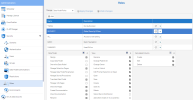Roles
Roles define what each user can do in SEI. There are two types of roles: General Roles and Data Model Roles.
Add a role
- In the Administration section, expand the Security dropdown menu.
- Select Roles.
- In the upper-left corner, use the Manage dropdown menu to select the role type.
- Select Add.
- Enter a name and, optionally, a description. Then select Create.
- The new role is added to the list. You can now assign permissions to it.
Assign permissions
- In the Administration section, expand the Security dropdown menu.
- Select Roles.
- In the upper-left corner, use the Manage dropdown menu to select the role type.
- Select the appropriate permissions for the selected role.
- Select Apply Changes to save, or Undo changes to discard your updates.
General Roles
General roles control access and actions in various parts of the application interface. They are grouped into the following permission categories: Administration, Command Center, Folder, Dashboard, Reports, Excel Add-in
| Category | Permission |
|---|---|
| Administration |
Manage Security Manage Global Parameters Manage Global Variables Manage Distribution Manage External Locations Environment & Data Sources Manage Global Scripts Manage Application Links Manage Global Selection Pages Manage License Information Manage Dictionary Languages Manage Excel Publish OLAP Manager Create Installation Template Manage Installation Template Import Template Manage Data Warehouse Manage Reporting Trees |
| Command Center |
Organize Command Center Data Models Organize Command Center Views Create Data Model |
| Folder |
Create Rename Delete |
| Dashboard |
Rename Change Publish for Change Owner Lock or Unlock Open Create Design Save As Delete Subscribe to Distribution Add other emails in To, Cc and Bcc Send Comment Export Use Filtering Function Remove Filters |
| Reports |
Rename Change Publish for Change Owner Lock or Unlock Open Create Design Save As Delete Subscribe for Distribution Add other emails in To, Cc and Bcc Send Comment Export Use filtering function |
| Excel Add-in |
Formula wizard Formula drill-down Data Entry Link to formula Pivot Table Pivot Table Refresh Duplicator Data Extraction Data Extraction Refresh Prompt Quick Prompt Create Static Copy References Configuration Change Password Open View Refresh Formulas Data Model Configurations Environment Configurations Reporting Tree Selector Reporting Tree Node Selector Reporting Tree Duplicator |
| Workbook |
Copy Folder Rename Create Save As Delete Toolbar Visibility |
| OLAP Manager |
Add and Save Cube Copy and Delete Cube Navigation Build Load All Refresh |
Data Model Roles
Data Model roles define what a user can do within data models, such as creating data models, exporting views, and creating calculated columns.
By default, SEI includes three predefined roles: SECURITY, BASIC, MANAGER. You can modify these roles or create new ones as needed.
Data model permissions are grouped into the following categories: Data Model, View, Calculated Column, and Filter.
| Category | Permission |
|---|---|
| Data Model |
Design Copy Data Model Overwrite Data Model Manage Selection Pages Manage Data Model Parameters Manage Stored Procedures Translate Data Model Manage Info Pages View Info Pages Create Documentation View Documentation Rename Delete |
| View |
Rename Change Publish for Change Owner Lock or Unlock Edit Prompt Selection on Open Open Save Create Save As Delete Subscribe to Distribution Add other emails in To, Cc and Bcc Send Comment Export Use Data Entry |
| Calculated Column |
Create Edit Delete |
| Filter |
Create Save Rename Change Publish for Change Owner Lock or Unlock View Apply Predefined Filters Delete Predefined Filters Use Filtering Function Edit Advanced Filter Remove Filters |
The Delete Predefined Filters permission lets you remove predefined filters only. When this permissions is enabled for a role, the X icon that appears when you hover over a filter is hidden.
In contrast, the Remove Filters permission allows you to remove any filter from views and dashboards during your analysis.

